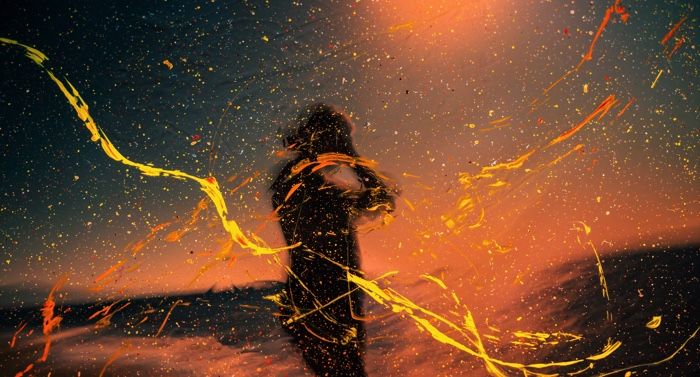
Genre Blends We Need More Of
Genre-blending is a time-honored tradition, but we often see the same few blends — the paranormal romance, the sci-fi horror, the historical mystery — regurgitated again and again for years at a time. There are so many overlooked genre blends we need more of on our shelves and nightstands. I’ve picked out seven to talk about here, but trust me — there are as many possibilities as you can imagine, waiting for someone to write them.
The thing I love about a well-done genre blend is how malleable it proves the borders of our literary genres to be. So many so-called high-brow speculative titles came out in the 2010s that we stopped talking about the difference between genre and literary fiction for a little while. During that time, we just accepted that books could be both literary and genre, and that was okay. It still is, but that hasn’t stopped the discourse from popping up on Twitter now and again.
But what about genres that are supposedly polar opposites? Can you really blend sci-fi and fantasy, or romance and horror? What would a cozy horror novel even look like?
Hint: I’ve got some examples for you below.
From sci-fi romance to cozy everything, these are the literary genre blends we need more of in our favorite bookstores and libraries.

Cozy Everything
When you hear “cozy,” you probably think of cozy mysteries, which feature amateur detectives — think Jessica Fletcher and Miss Marple — solving murder cases that are low on terror and gore. These are the kind of feel-good books you want to take with you to the beach or the laundromat. They don’t ask a lot of you, but they provide a whole lot of fun in return.
When the news feed looks something like Truly Awful Thing following Truly Awful Thing, readers tend to turn in one of two directions. Either they read horror novels to prove they can survive the Truly Awful Things, or they turn to feel-good books to cushion themselves against a terribly sharp and unforgiving world.
It’s no surprise, then, that we’ve seen cozies appear in genres beyond the usual mystery recently. Cozies have long been a quiet staple of both genre — Howl’s Moving Castle — and literary — Tales of the City — fiction. Now, they’re finally starting to get the attention they deserve. And we need more.
So give us more cozy sci-fi books like A Psalm for the Wild-Built and The Tea Master and the Detective. Bring on the cozy fantasy, à la Legends & Lattes and Witchmark. Let me see your romances without the third-act breakup — looking at you, Morning Glory Milking Farm and The Duke Who Didn’t! And yes, give me cozy horror, because We Have Always Lived in the Castle walked so The Undead Truth of Us could run.
Prop up our nightstands with cozy everything, because it looks like we’re in for a bumpy ride.
Fantasy Horror
Sci-fi horror gets so much attention. Not for any terrible reason, of course. Alien and Event Horizon are genre-blended classics; The Luminous Dead and We Have Always Been Here are their literary cousins.
With the greatness of those titles duly recognized, can we get a little appreciation for fantasy horror? It’s true that, in space, no one can hear you scream. But couldn’t the same be said of a silence spell’s area-of-effect, the deepest of the dwarven mines, or the third basement of a wizard’s crypt?
Now, you might rightly say that there’s a little fantasy in every work of supernatural horror. How else do you explain away the ghosts, demons, werewolves, and vampires, if not as fantasy?
This is not to say that fantasy horror isn’t already A Thing; it most certainly is. This genre blend has given us books like The Bone Witch, Trail of Lightning, The Red Tree, and The Ocean at the End of the Lane. It’s been around for a long, long time and has a long, long road ahead of it. But that won’t stop me from reiterating, over and over again, just how much we need more fantasy horror on our shelves.
Historical Horror
Another horror blend?
Yes.
Just as with fantasy horror above, none of what I’m about to say should be taken to mean that historical horror isn’t already an established genre blend. Thanks to that Cthulhu guy and his buddies, we’ve got a wealth of horror books from the last century set in the 1920s and ’30s. But what about the other great epochs? Surely there are horror stories to be told then, right?
Right.
Alma Katsu alone has tackled the Donner Party (The Hunger), the sinking of the Titanic (The Deep), and Japanese-American internment (The Fervor). Silvia Moreno-Garcia took us to the Mexican countryside of the 1950s in Mexican Gothic, and her forthcoming Silver Nitrate is a 1990s-set thriller about what might be a Nazi curse. Historical horror novels set in the 19th century and before include The Hacienda, Between Two Fires, The Silent Companions, Black Fire, and What Moves the Dead.
With all of these titles lined up like this, it would be easy to think that perhaps we have enough historical horror novels to choose from.
Nope.
We need more. We need 1960s protest horror and 1970s serial killer horror and 1980s Satanic Panic horror. Heian and Muromachi and Edō horror. Meiji and Taishō and Shōwa horror. Horror about Byzantine monks and Ottoman princesses and Chandela architects. Give us more historical horror, and give it to us right the hell now.
Punk Punk
Steampunk novels dominated speculative fiction in the Aughts, much as cyberpunk did in the 1980s and ’90s. But did you know that there are many, many more retrofuturistic science fiction and fantasy sub-genres with the -punk suffix? These “punk punk” sub-genres combine historical — or historically inspired — settings with anachronistic technologies.
Here are a few of these sub-genres, complete with examples that will have you hankering for more:
Atompunk
If you’ve ever played Fallout, you’re already intimately familiar with atompunk. Also known as “raygun gothic,” this sci-fi sub-genre imagines a future that looks very much like the science fiction of the 1950s and ’60s — with a dark edge, of course. Elan Mastai’s All Our Wrong Todays is the most prominent, recent example of this retrofuturistic sub-genre, but Adam Christopher’s Ray Electromatic Mysteries series is worth checking out as well.
Clockpunk
You’ll often find clockpunk lumped in together with steampunk, but this sub-genre deserves its own spotlight. Unlike steampunk, which is largely based around Victorian aesthetics, clockpunk looks to the Renaissance and the Age of Enlightenment for inspiration. Notable clockpunk books include Philip Pullman’s Clockwork and Brandon Sanderson’s The Rithmatist.
Dieselpunk
My personal favorite of the punk punks, dieselpunk draws on visions of the future from the 1920s, ’30s, and ’40s, in all their Art Deco glory. Adam Christopher’s Empire State and The Age Atomic are must-reads here, as are Dave Stevens’ The Rocketeer and Vesna Kurilić’s Johnny’s Girls.
Oceanpunk
If you grew up loving Waterworld, this one’s for you. Also known as “seapunk,” oceanpunk features characters who are at home on the high seas — or even below them. Check out China Miéville’s The Scar and Nnedi Okorafor’s Lagoon, then go write your own oceanpunk story — seriously, we need more.
Romantic Science Fiction
Fantasy romance books are everywhere, but sci-fi romances get much less attention. Ruby Dixon’s Ice Planet Barbarians series made BookTok familiar with the alien subset of monster romances. For readers looking for a softer side of sci-fi, there’s They Both Die at the End by Adam Silvera.
But where should you turn if you’re into romantic novels, but don’t exactly vibe with romance romances? Thankfully, there are plenty of romantic sci-fi novels where the love and lust remain in the realm of sideplot. Alechia Dow’s The Kindred and Nina Varela’s Crier’s War are two prominent examples, and — spoiler alert — the angst does pay off in Tamsyn Muir’s Gideon the Ninth.
There’s room for a lot more romance in the sci-fi field, especially since romantic sci-fi novels routinely go overlooked in favor of their fantasy cousins. So publishers, I beg you: give us more cyborg love affairs, rendezvous aboard generation ships, and space captains kissing green women — please and thank you.
Speculative Mystery
According to some of the oldest and most basic rules of mystery fiction, “All supernatural or preternatural agencies [must be] ruled out as a matter of course.” Not only does this mean that no magic, time travel, psionic abilities, aliens, ghosts, or other ghoulies can factor into a mystery story, but it also rejects the idea of a sleuth who might suspect some sort of eldritch foul play.
Bully to mystery fiction’s Old Guard, but I’m going to have to disagree with them. Speculative mysteries might play by different rules, but they still play fair — meaning the reader has all the information they need to solve the mystery alongside the sleuth. Must-reads in this vein include S.A. Barnes’ Dead Silence, Mary Robinette Kowal’s The Spare Man, Mur Lafferty’s Six Wakes and Station Eternity, Chris McKinney’s Midnight, Water City, Gigi Pandian’s Under Lock & Skeleton Key, and the aforementioned Gideon the Ninth. Pick some of those up, and then just try and tell me you aren’t dying for more.
Want more books that linger on the borders of genre? Check out these lists of genre-blending science fiction, fantasy, and horror novels.











